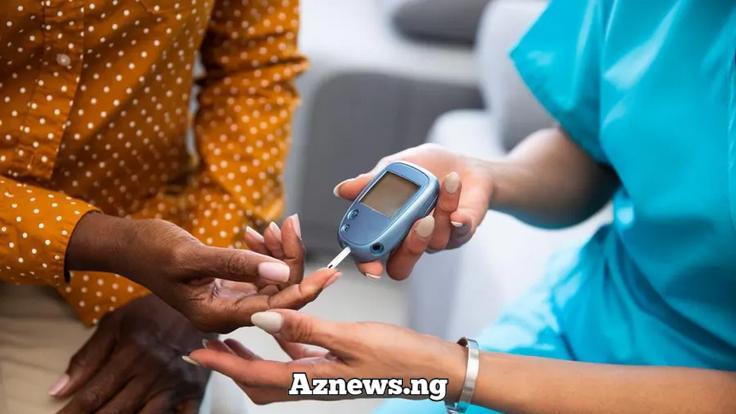
Type 2 diabetes is the most common form of diabetes. It occurs when blood sugar levels rise due to problems with insulin use or production. It may occur at any age, but it is more likely to occur after the age of 45. This article examines the early signs and symptoms of type 2 diabetes, risk factors and potential complications......Read The Full Article>>.....Read The Full Article>>
What is type 2 diabetes?
Some symptoms of type 2 diabetes may include tiredness, increased hunger and increased thirst. People with type 2 diabetes do not make or use insulin properly. Insulin is a hormone that regulates the movement of blood glucose, or sugar, in cells, that use it as energy.
When sugar cannot enter the cells, it means:
– too much glucose builds up in the blood
– the body’s cells cannot use it as an energy source.
A doctor may diagnose diabetes if a person’s blood sugar is equal to or greater than 126 milligrams per deciliter (mg/dl) after an 8-hour fast.
Symptoms of type 2 diabetes mellitus
Symptoms of hyperglycaemia in type 2 diabetes tend to appear gradually. People with type 2 diabetes do not notice all symptoms in the early stages.
If a person has symptoms, they may notice the following:
– Frequent urination and increased thirst: When excess glucose builds up in the bloodstream, the body extracts fluid from the tissues. This may lead to excessive thirst and the need to drink and urinate further.
– Increased hunger: In the case of type 2 diabetes, cells are not able to access glucose to obtain energy. Muscles and organs lack energy, and the person may be more hungry than usual.
– Weight loss: When there is too little insulin, the body may start burning fat and muscles to get energy. This leads to weight loss.
– Fatigue: When the cells lack glucose, the body gets tired. Fatigue can disrupt the daily life of a person with type 2 diabetes.
– Blurred vision: Hyperglycaemia may cause fluid to be inhaled into the lenses of the eyes, causing swelling and temporarily blurred vision.
– Infections and wounds: It takes longer to recover from infections and wounds because the blood flow is poor and there may be other nutritional deficiencies.
If people notice these symptoms, they should see a doctor. Diabetes can lead to a number of serious complications. The sooner a person starts managing their glucose levels, the more likely they are to prevent these complications.
Symptoms in children and adolescents
Type 2 diabetes is more likely to occur after the age of 45, but it may affect children and adolescents who:
– have excess weight
– do not engage in much physical activity
– make high blood pressure
– have a family history of type 2 diabetes mellitus
The following symptoms may occur:
– weight loss, despite increased appetite and hunger
– extreme thirst and dry mouth
– frequent urination and urinary tract infections
– tiredness
– blurred vision
– slow healing of cuts or wounds
– numbness or tingling in the hands and feet
– itching of the skin
If the caregivers notice these symptoms, they should take the child to the doctor. These are also symptoms of type 1 diabetes. Type 1 is less common, but it affects children and adolescents more often than adults. However, type 2 diabetes is becoming more common in young people than in the past.
Symptoms in the elderly
They may also have one or more of the following symptoms:
– influenza-like fatigue, which includes a feeling of lethargy and chronic weakness
– urinary tract infections
– numbness and tingling in the hands, arms, legs and feet due to impaired traffic and nerves
– dental problems, including red and inflamed mouth infections and gums.
Early signs
A classic early symptom of diabetes can be a cut that takes a long time to heal. Most people don’t experience symptoms in the early stages, and they may not be symptoms for many years to come.
A possible early sign of type 2 diabetes is dark skin in certain areas of the body, including:
the neck
elbows
knees
the joints
This phenomenon is known as acanthosis nigricans.
Other early symptoms are as follows:
frequent infections of the bladder, kidneys or skin
Cuts that take longer to heal
tiredness
extreme hunger
increased thirst
urine frequency
blurred vision.
A person may have mild or subtle symptoms for many years, but these may get worse over time. Other health problems may develop.
Prediabetes and diabetes prevention
A person with a blood glucose level between 100 and 125 mg/dl will be diagnosed with prediabetes. This means that its blood sugar level is high, but it does not have diabetes. Taking action at this stage may prevent the development of diabetes.
Long-term complications of diabetes
Maintaining blood glucose within the targets sets prevents complications that can, over time, be life-threatening and disabling.
Here are some of the possible complications of diabetes:
– diseases of the heart and blood vessels
– high blood pressure
– nerve damage (neuropathy)
– lesions of the feet
– eye damage and blindness
– kidney disease
– hearing problems
– skin problems
